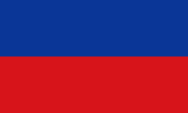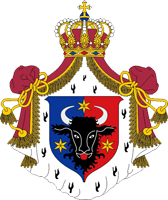Bukowina |
|
|
|
| Übersicht – Contents: | |
Diese Seite ist Teil des Projektes
Bukowina |
|
|
|
| Übersicht – Contents: | |
Flagge – Flag: |
|
 |
Landesflagge (Landesfarben) – Flag of the country (colours), Seitenverhältnis – ratio = 2:3, Quelle/Source nach/by: Flags of the World |
|
|
|
Bedeutung/Ursprung der Flagge – Meaning/Origin of the Flag: |
|
| In der Zeit der Monarchie hatte das Land, wie alle Kronländer der österreichischen Krone, seine eigenen, sogenannten Landesfarben, die unter anderem auf horizontal getreiften zwei- oder dreistreifigen Flaggen gezeigt wurden. Die Landesfarben waren sehr oft dem jeweiligen Wappen des Kronlandes entnommen oder wurden duch eine weitere, nicht im Wappen enthaltene Farbe ergänzt, oder sie gingen auf ältere Modelle des Landeswappens zurück (z.B. Krain). Offiziell waren die Landesfarben aber nie geregelt oder festgelegt worden, so dass deren Reihenfolge in der Praxis of variierte oder die Farben gar an sich abwichen. Der österreichische Heraldiker Hugo Gerard Ströhl (1851–1919) hat sich wohl als erster des Themas angenommen und wahrscheinlich um das Jahr 1890 herum die Landesfarben auf den Flaggen bei den jeweiligen Landesbehörden abgefragt und zusammengestellt. Für Bukowina wurden Blau und Rot als Landesfarben für das Kronland ermittelt. |
In the time of the
monarchy, the country had – like all the other crown lands of the Austrian
crown – its own colours (Landesfarben), which were used amongst others on
horizontally two- or three-striped flags. The colours (Landesfarben) were very often taken from the respective coat of arms of the country or were supplemented by another colour, which not appears in the coat of arms, or they went back to older models of the coat of arms (e.g. Carniola). Officially, the colours had never been regulated or stipulated, so that their sequence varied in practice or even the colors deviated. The Austrian heraldist Hugo Gerard Ströhl (1851–1919) was probably the first to take care of it and asked for the colors (Landesfarben) on the flags at the respective state authorities around 1890 and compiled them. For Bukovina, blue and red were ascertained as the country's colors of the crown land. |
| Das Kronland Herzogtum Bukowina verwendete eine Flagge mit zwei horizontalen Streifen in den Landesfarben Blau und Rot. Die Farben sind die des alten Fürstentums Moldau, zu dem die Bukowina bis 1775 gehörte, und sind dem Wappen entnommen. | The crown land Duchy of Bukovina used a flag with two horizontal stripes in the country's colours blue and red. The colors are those of the old Principality of Moldova, to which Bukovina belonged until the year 1775, and were taken from the coat of arms. |
| Quelle/Source: Wikipedia (D), Österreichisch-Ungarische Wappenrolle, Volker Preuß | |
Wappen – Coat of Arms: |
|
 |
ca.1890–1918, Wappen Herzogtum Bukowina – coat of arms of the Duchy of Bukovina, Quelle/Source, nach/by: Ströhl, Wappenrolle Österreich-Ungarns, 1890, via Wikipedia (D) |
Bedeutung/Ursprung des Wappens – Meaning/Origin of the Coat of Arms: |
|
| Das Wappen der Bukowina geht auf das Wappen des Fürstentums Moldau zurück, und zeigt einen schwarzen Büffelkopf mit roter Zunge und silbernen Hörnern auf einem vertikal geteilten blau-roten Schild und drei goldene sechszackige Sterne. Es wurde am 09.12.1862 verliehen. Die Wappen des Fürstentums Moldau und des russischen Gouvernements Bessarabien waren ähnlich: Das Wappen des Fürstentums Moldau zeigte einen waagerecht blau-rot geteilten Schild mit einem goldenen Büffelkopf, das Wappen von Bessarabien einen goldenen Büffelkopf mit roter Zunge und und roten Hörnern. |
The coat of arms of
Bukovina goes back to the coat of arms of the Principality of Moldova and
shows a black buffalo head with a red tongue and silver horns on a
vertically divided blue-red shield and three golden six-pointed stars. It
was awarded on 9th of December in 1862. The coats of arms of the Principality of Moldova and the Russian governorate of Bessarabia were similar: The coat of arms of the Principality of Moldova showed a horizontally blue-red divided shield with a golden buffalo head, the coat of arms of Bessarabia showed a blue shield with golden buffalo head with a red tongue and red horns. |
| Quelle/Source: Wikipedia (D), Österreichisch-Ungarische Wappenrolle, Volker Preuß | |
| die Kronländer Österreich-Ungarns – Crown Lands of Austria-Hungary: |
|
| Quelle/Source: Volker Preuß |
| Landkarte der Bukowina – Map of Bukovina: |
|
| Landkarte/Map: Volker Preuß |
Zahlen und Fakten – Numbers and Facts: |
|
|
|
|
|
|
|
|
|
|
|
|
|
|
|
|
Geschichte: |
| ca. 7.
Jhd. · Besiedlung durch Ruthenen ca. 1350 · Besiedelung durch Rumänen 1359 · zum Fürstentum Moldau 14. Jhd. · Lehen des Königreiches Polen ca. 1450 · Besiedelung durch Polen, Armenier und Griechen 1482 · erste urkundliche Erwähnung der Landschaft Bukowina seit 1455 · türkischer Einfluss 1511 · Moldau kommt unter Oberhoheit des Osmanischen Reiches ca. 1650 · Besiedelung durch Ungarn 1769 · russische Eroberung 1774 · Russland gibt Bukowina an das Osmanische Reich zurück 1775 · Österreichische Truppen besetzen das Land 07.05.1775 · das Osmanische Reich tritt das Land an Österreich ab, die Bukowina wird Herzogtum 01.11.1786 · Aufhebung der österreichischen Militärverwaltung, zum Königreich Galizien 1848/1849 · Revolution in Wien, neue Verfassung: die Titular-Erblande der Habsburger im Kaiserreich Österreich werden zu Kronländern mit eigenen Landtagen umgewandelt, das Herzogtum Bukowina bleibt zunächst ein Teil des Kronlandes Galizien 1861 · Abtrennung der Bukowina (Buchenland) von Galizien als eigenes Kronland des Kaiserreichs Österreich 1919 · im Zuge der Auflösung Österreich-Ungarns kommt das Buchenland an Rumänien Juni 1940 · der Nordteil des Buchenlandes wird von der Sowjetunion okkupiert und der Sowjetukraine angeschlossen Juni 1941 · Rumänische Truppen erobern den Nordteil des Buchenlandes während des Zweiten Weltkriegs zurück April/Mai 1944 · Sowjetische Truppen erobern das Buchenlandes während des Zweiten Weltkriegs, erneute Teilung, der Nordteil wird der Sowjetukraine angeschlossen (bis dato), der Südteil verbleibt bei Rumänien |
History: |
| ca. 7th
cent. · settlement by Ruthenians ca. 1350 · settlement by Romanians 1359 · to the Principality of Moldavia 14th cent. · fiefdom of the Kingdom of Poland ca. 1450 · settlement by Polish, Armenians and Greek 1482 · first documentary mention of the Landscape of Bukovina since 1455 · Turkish influence 1511 · Moldavia comes under supremacy of the Ottoman Empire ca. 1650 · settlement by Hungarians 1769 · Russian conquest 1774 · Russia gives back Bukovina to the Ottoman Empire 1775 · Austrian Troops occupy the country 7th of May 1775 · the Ottoman Empire cedes the country to Austria, Bukovina becomes a duchy 1st of November 1786 · end of the Austrian military administration, to the Kingdom of Galicia 1848/1849 · revolution in Vienna, new constitution: the titular hereditary territories of the Habsburgs in the Austrian Empire become converted to crown lands with their own Landtag (parliament), the Duchy of Bukovina remains initially a part of the crown land of Galicia 1861 · separation of Bukovina (Buchenland) from Galizia as an own crown land of the Austrian Empire 1919 · in context with the dissolution of Austria-Hungaria comes Bukovina to Romania June 1940 · the northern part of Bukovina becomes occupied by the Soviet Union and incorporated to the Soviet Ukraine June 1941 · Romanian troops conquer back the northern part of Bukovina during the Second World War April/May 1944 · soviet troops conquer Bukovina during the Second World War, once more division, the northern part becomes incorporated to the Soviet Ukraine (until today), the southern part remains at Romania |
| Quelle/Source: Atlas zur Geschichte, Wikipedia (D), World Statesmen Meyers Konversationslexikon 1885-1892, Discovery '97, Volker Preuß |
Ursprung des Landesnamens – Origin of the Country's Name: |
|
| Die Bezeichnung "Bukowina" stammt aus dem Mittelalter und heißt "Buchenland", denn das Wort "buk" bedeutet in vielen slawischen Sprachen "Buche". Der Name des Landes geht auf die früher hier vorherrschenden Buchenwälder zurück. | The name "Bukowina" comes from the Middle Ages and means "Buchenland" ("beech tree land"), because the word "buk" means "beech" in many Slavic languages. The name of the country goes back to the beech forests which then growed here. |
| Quelle/Source: Handbuch der geographischen Namen | |
|
• Reich der Österr. Habsburger (bis 1804) • Kaiserreich Österreich (1804–1867) • Österreich-Ungarn (1867–1918) • Republik Österreich (seit 1918) |
• Empire of the Austrian Habsburgs (to 1804) • Empire of Austria (1814–1867) • Austria-Hungary (1867–1918) • Republic of Austria (since 1918) |